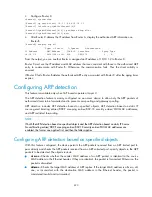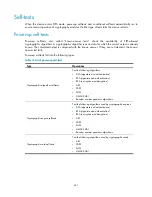
432
NOTE:
•
IP addresses already existent in ARP entries are not scanned.
•
ARP automatic scanning may take some time. To stop an ongoing scan, press
Ctrl
+
C
. Dynamic ARP
entries are created based on ARP replies received before the scan is terminated.
•
The static ARP entries changed from dynamic ARP entries have the same attributes as the static ARP
entries manually configured.
•
Use
arp fixup
to change the existing dynamic ARP entries into static ARP entries. use this command
again to change the dynamic ARP entries learned later into static ARP entries.
•
The number of static ARP entries changed from dynamic ARP entries is restricted by the number of
static ARP entries that the device supports. As a result, the device may fail to change all dynamic ARP
entries into static ARP entries.
•
To delete a specific static ARP entry changed from a dynamic one, use
undo arp
ip-address [ vpn-
instance-name ]. To delete all such static ARP entries, use
reset arp all
or
reset arp static
.
Configuring ARP gateway protection
The ARP gateway protection feature, if configured on ports not connected with the gateway, can block
gateway spoofing attacks.
When such a port receives an ARP packet, it checks whether the sender IP address in the packet is
consistent with that of any protected gateway. If it is, it discards the packet. If it is not, it handles the
packet normally.
Configuration procedure
To do…
Command…
Remarks
1.
Enter system view.
system-view
—
2.
Enter Layer 2 Ethernet interface
view.
interface
interface-type interface-
number
—
3.
Enable ARP gateway protection
for a specified gateway.
arp filter source
ip-address
Required
Disabled by default
NOTE:
•
You can enable ARP gateway protection for up to eight gateways on a port.
•
Commands
arp filter source
and
arp filter binding
cannot be both configured on a port.
•
If ARP gateway protection works with ARP detection, MFF, ARP snooping, and ARP fast-reply, ARP
gateway protection applies first.
ARP gateway protection configuration example
Network requirements
As shown in
, Host B launches gateway spoofing attacks to Router B. As a result, traffic that
Router B intends to send to Router A is sent to Host B.
Configure Router B to block such attacks.






























